Games for CogniMotion Rehabilitation
The Motion system improves the patient’s motor, cognitive and functional status. We use an off-the-shelf 3D camera system to analyze patient movements to verify accurate functional motions while practicing a variety of functional tasks and games. Below are samples of games currently being used. Additional games are available and more are being added with each new system release.
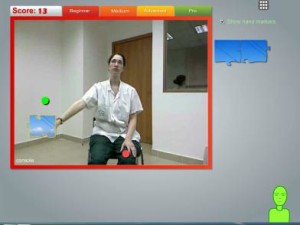 Puzzle Game. Client reaches to touch puzzle pieces as they appear on the screen. Pieces are automatically placed in the correct location when touched. Level of difficulty is changed by pieces appearing at locations that require larger shoulder range of motion and by successively requiring that the client dwell on one or two pieces (not just touch them). This is a simple, warm-up game with easy motor and cognitive requirements.
Puzzle Game. Client reaches to touch puzzle pieces as they appear on the screen. Pieces are automatically placed in the correct location when touched. Level of difficulty is changed by pieces appearing at locations that require larger shoulder range of motion and by successively requiring that the client dwell on one or two pieces (not just touch them). This is a simple, warm-up game with easy motor and cognitive requirements.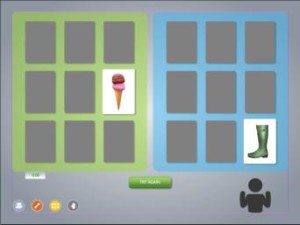 Memory Game. Classic ‘memory’ game in which cards on each side of the screen are exposed until a match is found. Client selects cards by touching them. Level of difficulty can be changed to suit the client’s abilities. Memory and motor requirements can be graded by changing the number of cards. In addition, motor requirements can be adjusted by changing the location (i.e., height) of the cards and memory requirements can be adjusted by selecting different card photos (e.g., level of familiarity and complexity of photos).
Memory Game. Classic ‘memory’ game in which cards on each side of the screen are exposed until a match is found. Client selects cards by touching them. Level of difficulty can be changed to suit the client’s abilities. Memory and motor requirements can be graded by changing the number of cards. In addition, motor requirements can be adjusted by changing the location (i.e., height) of the cards and memory requirements can be adjusted by selecting different card photos (e.g., level of familiarity and complexity of photos).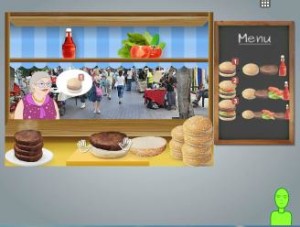 Fast-food Game – Pizza. Client responds to fast-food orders (pizza) from customers in accordance with a displayed menu. Selection of food items is by touch. Level of difficulty may be adjusted by changing the shelf height and by increasing the time to complete the meal. The completed meal is dragged to the customer. This activity has moderate motor and cognitive requirements (e.g., sequencing, working memory, speed of processing).
Fast-food Game – Pizza. Client responds to fast-food orders (pizza) from customers in accordance with a displayed menu. Selection of food items is by touch. Level of difficulty may be adjusted by changing the shelf height and by increasing the time to complete the meal. The completed meal is dragged to the customer. This activity has moderate motor and cognitive requirements (e.g., sequencing, working memory, speed of processing).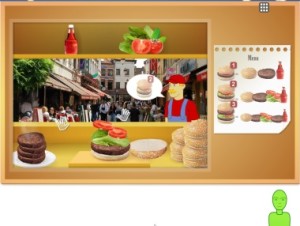 Fast-food Game – Hamburger. Client responds to fast-food orders (pizza or hamburger) from customers in accordance with a displayed menu. Selection of food items is by touch. Level of difficulty may be adjusted by changing the shelf height and by increasing the time to complete the meal. The completed meal is dragged to the customer. This activity has moderate motor and cognitive requirements (e.g., sequencing, working memory, speed of processing).
Fast-food Game – Hamburger. Client responds to fast-food orders (pizza or hamburger) from customers in accordance with a displayed menu. Selection of food items is by touch. Level of difficulty may be adjusted by changing the shelf height and by increasing the time to complete the meal. The completed meal is dragged to the customer. This activity has moderate motor and cognitive requirements (e.g., sequencing, working memory, speed of processing).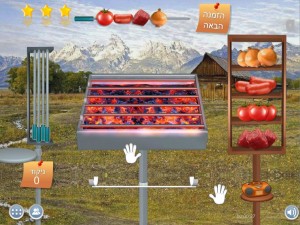 Grill. Client successively prepares, cooks and serves kebabs in accordance with a list of ingredients in a specific sequence (e.g., meat cubes, onion slices). Initially the task is simple since only one kebab needs to be prepared. Multitasking increases as subsequent kebabs appear and the client has to simultaneously monitor the kebab that is currently on the grill and turn it over to prevent burning and then to remove it to a plate to be served. Level of motor and cognitive difficulty may be adjusted by changing the number of kebabs that have to be monitored simultaneously as well as number of items on the list. The motor level may be adjusted by changing the height of items that need to be collected.
Grill. Client successively prepares, cooks and serves kebabs in accordance with a list of ingredients in a specific sequence (e.g., meat cubes, onion slices). Initially the task is simple since only one kebab needs to be prepared. Multitasking increases as subsequent kebabs appear and the client has to simultaneously monitor the kebab that is currently on the grill and turn it over to prevent burning and then to remove it to a plate to be served. Level of motor and cognitive difficulty may be adjusted by changing the number of kebabs that have to be monitored simultaneously as well as number of items on the list. The motor level may be adjusted by changing the height of items that need to be collected.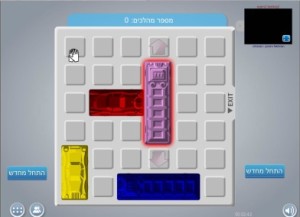 Marina. This activity requires the use of arm movements to plan a route to guide a specific boat out of the harbor. It requires moderate to high levels of mental planning in order to enhance performance efficiency. The level of difficulty is adjusted by the number of boats that block the boat that needs to be taken out of the marina.
Marina. This activity requires the use of arm movements to plan a route to guide a specific boat out of the harbor. It requires moderate to high levels of mental planning in order to enhance performance efficiency. The level of difficulty is adjusted by the number of boats that block the boat that needs to be taken out of the marina.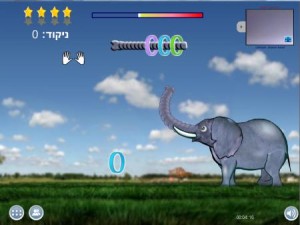 Elephant. The activity is controlled by up-and-down movements of the user’s legs and hands which cause the elephant’s trunk to catch rings and avoid other objects. The cognitive level is moderate (e.g., sequencing, inhibition) and the motor level may become more difficult in terms of cardiovascular effort.
Elephant. The activity is controlled by up-and-down movements of the user’s legs and hands which cause the elephant’s trunk to catch rings and avoid other objects. The cognitive level is moderate (e.g., sequencing, inhibition) and the motor level may become more difficult in terms of cardiovascular effort.